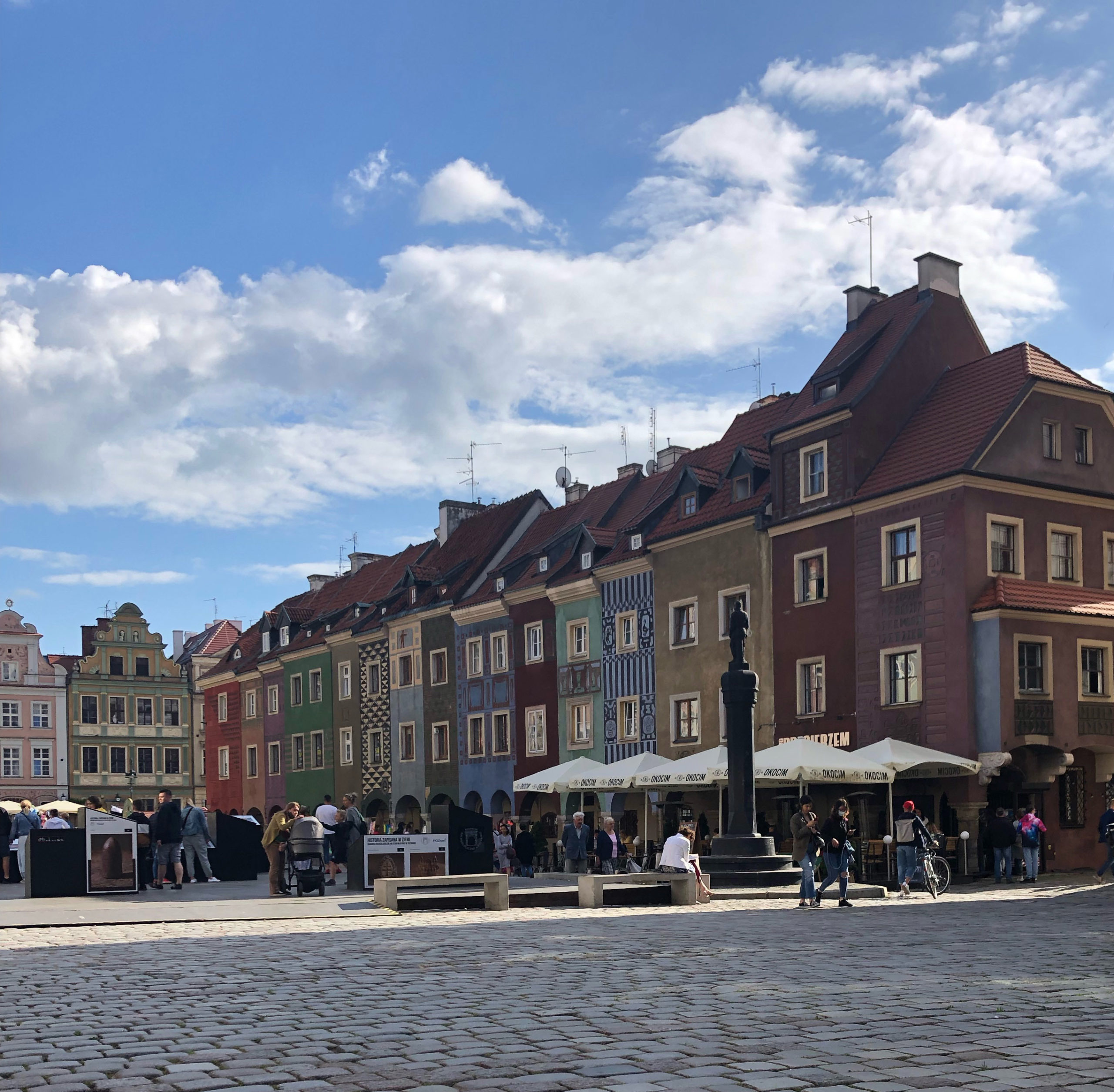
Poznan’s beautifully painted Old Town’s Square. Photo courtesy of Katarzyna Gabryelewicz
Poznań and a Day in the Country
Marie Marlo-Barski
September 21, 2021
My husband Andrew and I did what sensible adults only talk of doing: we quit our jobs to salvage what was left of our souls and went on a four-month tour of Europe, or as I call it, a two-for-one mid-life crisis. We stayed mainly in Eastern Europe as it is more affordable and because we have relatives there. It was grounding to reconnect with places from our younger days, see how we changed in three decades independently of one another, and glimpse into the lives of people we hold dear but know only superficially as they live three consecutive plane rides away.
I’ve learned by now that when we say “we’ll get together soon” that day never comes unless we firm up the plans right then and there. When the invitation from Kasia and Jeremy comes to spend an upcoming weekend at their country house, we pull out the calendar and confirm. We repack our suitcases for the second time in less than a week and are on our way again the following morning. The cab arrives just on time and this one smells of aftershave. It is overpowering but a huge improvement over the more common fermented cabbie odour baked into vehicles by the summer heat.
The train station is crowded. People are gathered under the announcement board, the kind they used to have at airports before electronic ones came along, with the little black cards that flip very fast listing upcoming departures and corresponding platforms. Andrew says that paying extra for reserved seats is not an option here, like with the nicer and newer German trains. A ticket means you can get on but doesn’t guarantee an actual seat; often, it is standing room only.
As I process this information, he continues, “When the train comes, I will run and get on, then you’ll pass me the bags through the window.” He is only half joking.
Sure enough as the train pulls in, everyone runs towards it and crowds at the entrances like nails on an oversized magnet. Any notion of personal space disappears instantly. Andrew, an old pro from his youth in this once communist country, is already on when I realize that I too will have to elbow my way in. Someone asks me a question and I lose Andrew from sight. I manage to get on the train and turn right when I hear him call from the left. He secured us seats. I am relieved to reach him in the crush of people.
This train is divided into compartments, each seating eight in a space that should only seat six. Again, my North American proportions are off. There is only another couple seated by the window, facing each other. This isn’t so bad, I think to myself, when a hefty woman pops her head in and asks if there is a seat available. She sits down, taking the space of one and a half persons according to the seat numbers.
Just then, the train is overrun by a horde of green uniforms, the Polish equivalent of boy scouts. Each has a man-sized backpack, probably weighing as much as the kid carrying it, and as wide as the train’s passageway. A young woman, one of the monitors, quickly determines there are still three seats in our cabin and promptly stuffs three boys in. We are now filled to capacity. Andrew and the other man manage to squeeze one of the giant back packs on the overhead luggage rack, along with a couple of smaller ones. The other two are left in the passageway, a scene that repeats itself for each compartment.
I remark to Andrew that this is a major safety violation as the bags block the passage, making a quick exit in case of emergency impossible. He laughs at me again. “You’ve got the window,” he replies.
Toto, I’ve a feeling we’re not in Kansas anymore…
As the train starts to roll, I suddenly notice many hands waving outside the windows: moms and dads seeing their kids off, the smiles not completely hiding the worry in their eyes. The boys are about ten or so, with no hint of puberty or teenage drama yet to come. Here I have to compliment Polish parents, their children are polite and well behaved. The boy next to me is sure to offer me and everyone in the compartment whatever candy or snack he is having. Polite does not mean quiet, and they chat and laugh incessantly. I don’t mind. It is nice to see this unencumbered joy of life, something we forget about later on. We learn they are off to a lake some eight hours away for the next three weeks. They all go to school together and live in the apartment’s vicinity that is our home base in Poland. We talk a bit about travelling and Justin Bieber, whom they don’t like. Their English is quite good, largely thanks to the miracle of the internet, I imagine. I am struck by how well socialized they are, speaking clearly and intelligently, looking us in the eyes, none of the squirming, eye rolling, and nodding I’ve seen in North American kids.
“Andrew laughs at the absurdity of such a precise schedule; not noon, but 11:59 although no train is ever on time. In that aspect, nothing has changed in the thirty years since he has been living in Canada.”
The train stops at every station, and sometimes inexplicably between stations, to sit and wait on the tracks. We are to arrive at 11:59 AM. Andrew laughs at the absurdity of such a precise schedule; not noon, but 11:59 although no train is ever on time. In that aspect, nothing has changed in the thirty years since he has been living in Canada.
We reach Poznań, say bye to the boys and wish them a nice summer. The train is forty-five minutes late and Kasia, who is waiting for us, had to move her car twice to avoid a parking ticket. Kasia is Andrew’s niece once removed, and she calls us “aunt and uncle,” which is endearing. I’ve liked her very much since I first met her. She was eight years old and happy to sing me a little song she had learned in English. She was a sweet and caring girl and is now a lovely young woman.
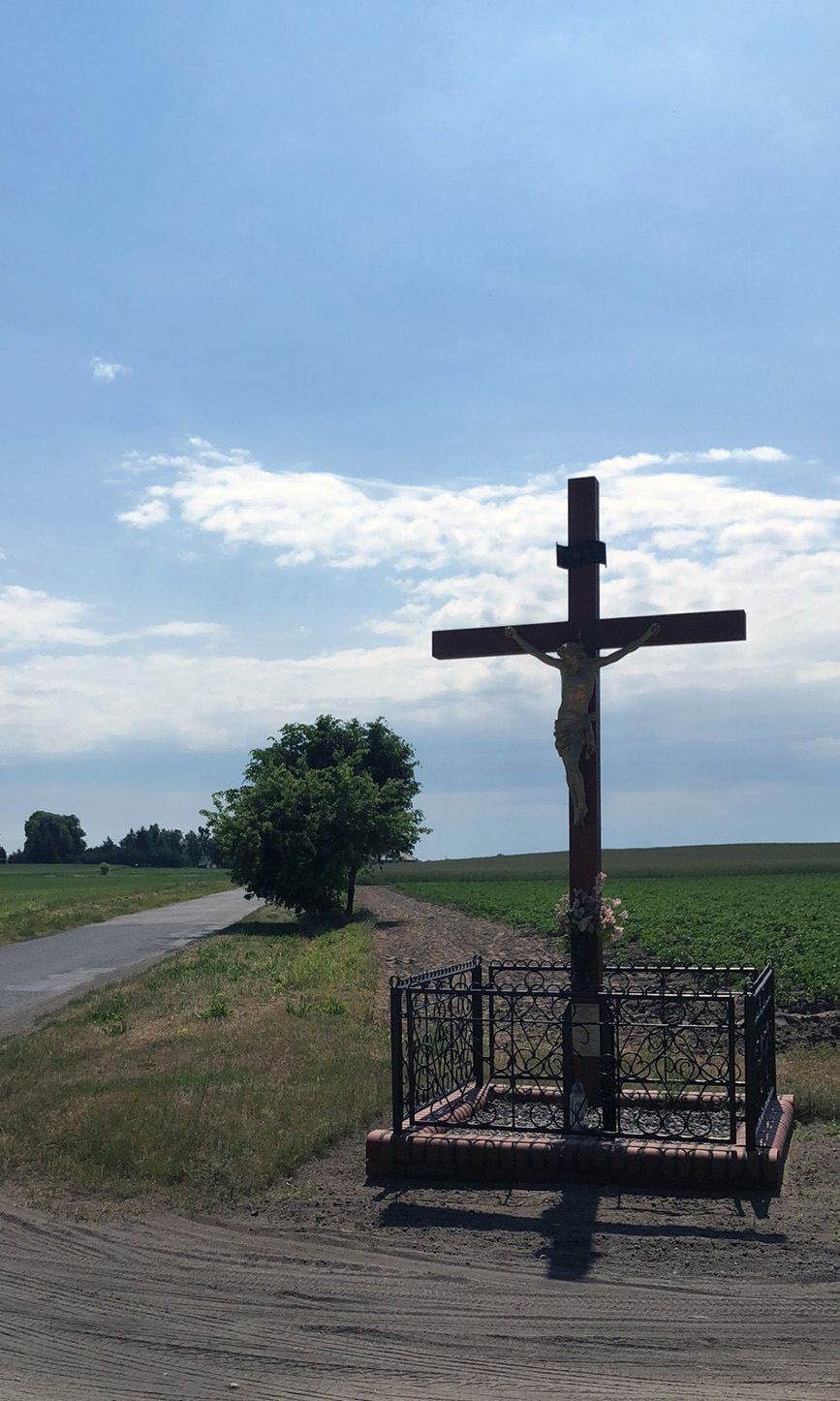
Many country intersections feature a crucifix or a statue of the Virgin Mary. Photo courtesy of Katarzyna Gabryelewicz
We zoom through the city and onto the highway, which takes us into the Polish countryside. Four lanes of traffic merge into two and then become a narrow country road. Kasia doesn’t slow down; she is still doing ninety down what should be a maximum forty kilometers per hour road. There is no speed limit sign in sight. I strap on the seat belt and make a silent prayer that no child or animal make a sudden appearance from the countless intersections hidden by tall stalks of corn. I notice that I never pray as often in Canada as I do when I am in Eastern Europe.
Kasia and her husband Jeremy bought a run-down property half an hour out of town (an hour if I was driving), which they have been renovating since their wedding a couple of years back. The day is clear and warm and the country is beautiful. I like the openness of the undulating fields, poked by an occasional farmhouse and barn. Many rural intersections feature a crucifix or a statue of the Virgin and flowers. It seems many locals also feel the need for divine help on these roads.
Kasia and Jeremy’s house is a lovely storybook brick cottage with flower baskets on every window. We are enthusiastically greeted by Ginger, their three-year-old beagle. With my dog far away in Canada I have been missing doggy companionship, so it is nice to pet his little furry head. We find Jeremy in the rear of their expansive yard, with a couple of helpers, landscaping. Jeremy is handsome and a little sunburned from working outside all day. He looks a bit like a young Marlon Brando, brooding, until he smiles and his whole face lights up like a child’s.
The house is as nice inside, full of rustic charm. We sit down to a lunch of pasta with spinach and chicken in tomato sauce. Ginger keeps my feet warm. I don’t mind, although it is a hot day. After coffee, the three of us get back in the car. Kasia has reserved a tour of the nearby castle for us while Jeremy gets back to his yard work.
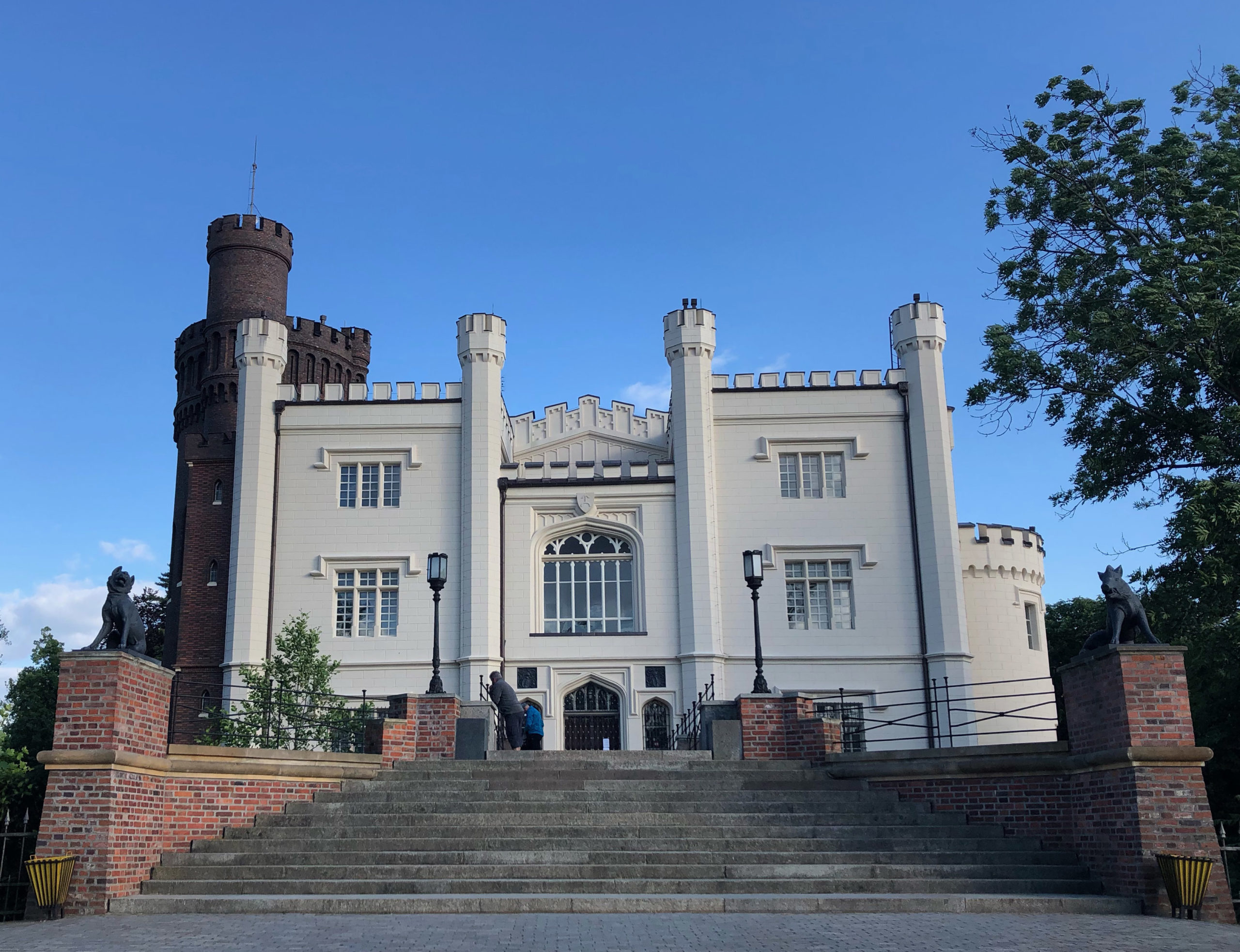
Kornik Castle, originally constructed in the 14th century and remodeled in 1855. Photo courtesy of Katarzyna Gabryelewicz
Kornik is an actual castle, complete with a moat and ghost. The original structure dates to about 1430. It went through several owners and renovations, including Teofila of Dzialynski, or the White Lady as she became known, named after a portrait of her in a white dress that still hangs in the castle. She lived from 1714 to 1790 and gave the castle a baroque feel, including a French style garden. According to folklore, she never really left and is the resident ghost of the castle. And like all good stories, there is treasure to be found. During a renovation, a treasure hidden in the basement went missing. The ghost will rest in peace once the treasure is recovered.
Our guide is a lovely young woman who speaks English well. She takes us from room to room where we admire the inlaid parquet flooring, the very elaborate wood mouldings and doorways, and the antique furniture. She points to hidden passageways. The tour ends in the library that houses not only rare books, but collections of trophies and memorabilia brought back from exotic places by some of the castle’s globe-trotting residents. After the castle, we tour the expansive grounds and talk about life. We get back to the car and Kasia takes us to a nearby palace, the former family residence of count Raczynski in Rogalyn, now a museum. The expansive palace was recently renovated. The cream-coloured façade and white accents seem even brighter in the late afternoon sun. There is a live concert in the garden, and we get to hear the last three songs. One low building on the grounds, which I imagine must have been a stable long ago, is converted to a small restaurant. We sit outside and order iced tea. The place is crowded so we share a table with a couple of strangers, but no one minds, everyone one is relaxed and having a nice time.
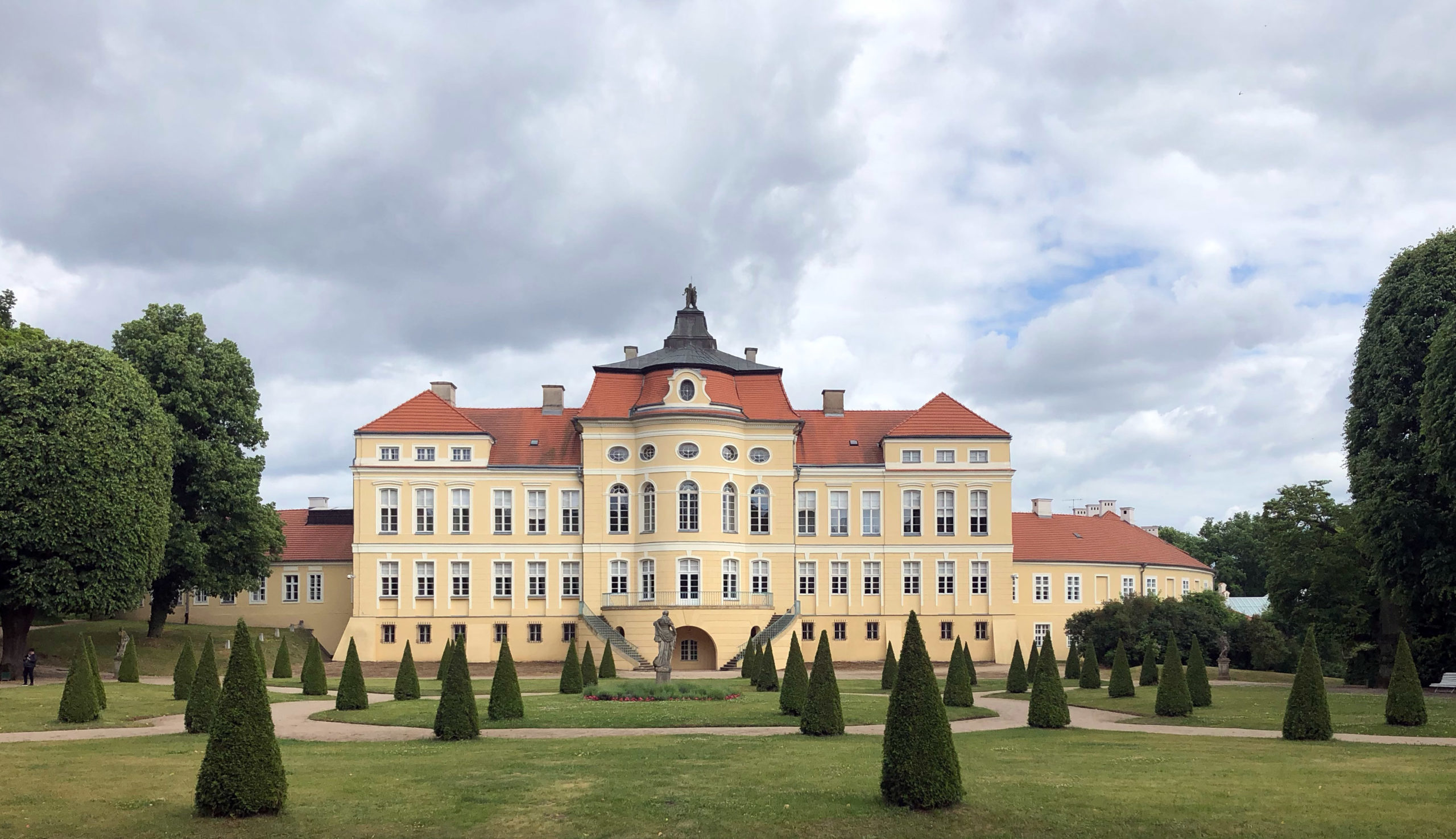
Raczynski’s Palace, completed in 1776. Photo courtesy of Katarzyna Gabryelewicz
We make our way back to the little brick house. Kasia gives us a tour of the property. There is a well dating from 1909, probably the same year as the house, and a brick barn that could itself become a lovely rustic house if renovated. I can’t help but think of all the shows I’ve seen where couples with passion and money undertake such projects. We go to the far end where Jeremy, now by himself, is still working hard pouring cement. They show us the work they did and explain their vision of what is to come, a terraced garden complete with fruit trees, herbs, flowers. I admire them for being so young, yet having such a clear vision of what they want out of life and working hard to get there.
For dinner we are joined by Tadziu and Kamil, Kasia’s father and brother. We help set the table outside on the brick patio. The evening is warm with a slight breeze and the conversations flow as does the wine. I think: This is what we need more of in Canada, evenings like this, with family and friends.
“The evening is warm with a slight breeze and the conversations flow as does the wine. I think: This is what we need more of in Canada, evenings like this, with family and friends.”
Kamil grills sausages made by a neighbour, while Ginger runs around investigating, disappearing into the tall grass to emerge again, face full of pollen. It is already dark when we disperse. Tadziu must catch the last train home to Ostrow; Kamil has a long drive to Warsaw, while we settle on the foldout sofa in the living room and promptly go to sleep.
Everything is peaceful until the first light of dawn, when the neighbourhood roosters start their opera. It is about 4:30 AM. Then the flies awaken and decide to examine me thoroughly. They tickle my bare arms and face. Waving them away doesn’t do much as they return time and time again, keeping me from getting back to sleep. I question my personal hygiene. I manage to dose off around six. When we get up at eight o’clock, Kasia and Jeremy are already up and dressed, making pancakes for breakfast. I take a long shower, scrubbing extra hard. It is already warm and we have pancakes and coffee outside. We are going to spend the day in Poznań, one of Poland’s oldest cities.
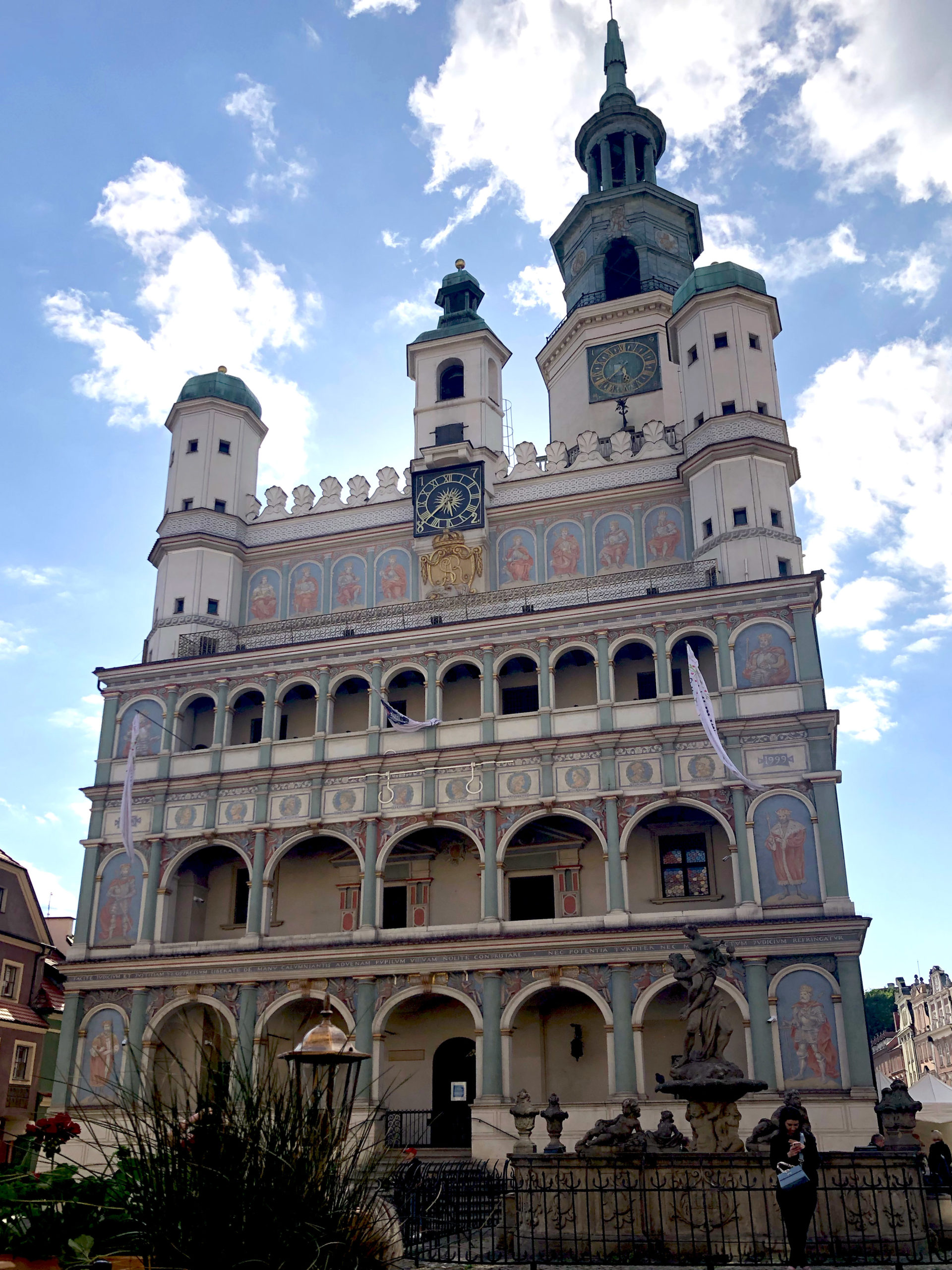
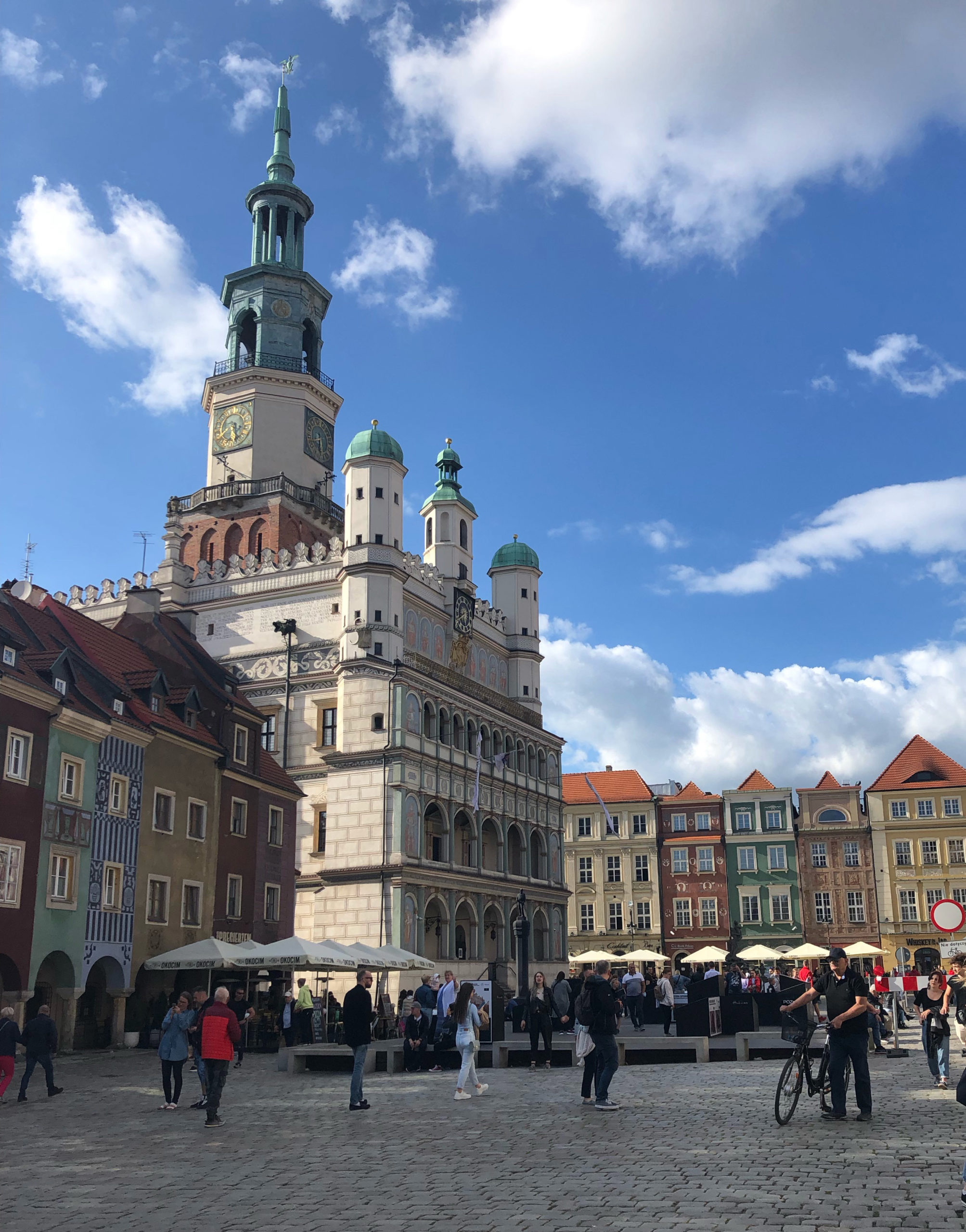
Poznań City Hall. The original structures date from the 13th century, the present façade was completed in 1560. Photos courtesy of Katarzyna Gabryelewicz
Like so many European cities, Poznań has a nicely restored historic plaza with cobblestone streets, tall, narrow buildings which have been lovingly restored, and churches. We find a crowd gathered outside City Hall. At noon every day, the City Hall tower offers a brief show: two mechanical Billy goats emerge slowly to face the people. They turn to each other and butt heads twelve times (I find myself counting along with the other spectators), then slowly return inside. This seems to entertain the adults more than the kids.
We turn left and head to what looks like a cathedral, calling from a narrow street at the end of the plaza. The Church of St. Stanislaus is an impressive structure in baroque ornamentation, one of the nicest I’ve seen. Next, we walk to the National Museum, which houses an extensive collection of Polish art and a few Renaissance pieces, including a gorgeous work by Botticelli of the Madonna and Christ child. After about three hours of “feeding our spirit” we are ready for actual food. Even Andrew has enough of looking at art; I thought that day would never come.
“The palace is beautiful [and]…I am tempted for a moment to be one of those people. I see myself as the chatelaine, running the household and hired help, and organizing huge parties. Then I think of the heating bill for such a place and snap back to reality.”
We settle on a nearby Greek restaurant. The décor of aqua blue and white is more Greek than the food itself, but we get a decent lunch and are on our way again. We visit the “Old Brewery” converted to an award-winning shopping center, a Gothic church begun in the 10th century entirely constructed from brick, and a park. We talk about many things, including Polish porcelain, and I fantasize about opening a shop in Canada.
On the way back, we drive to see an abandoned palace. There are many in the country, just waiting for a new owner to breathe life into them. The palace is beautiful, white and elegant, completely private, surrounded by a forest and a pond. I am tempted for a moment to be one of those people. I see myself as the chatelaine, running the household and hired help, and organizing huge parties. Then I think of the heating bill for such a place and snap back to reality.
Ginger is excited to see us all and runs back and forth, unable to make up his mind about whom to greet first. We have dinner outside and talk about Vegas. I’m not sure why we got on that topic, perhaps because it is the polar opposite of the beauty and history we experienced today.
Marie Marlo-Barski is originally from Yugoslavia. When Marie is not travelling, she is plotting her next adventure from her home base in Victoria, British Columbia, where she lives with her husband and their three dogs. She holds a BA in History of Art from the University of Winnipeg. Besides travelling, her interests include writing, painting, photography, and animal rights. English is her third language.
